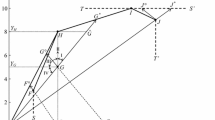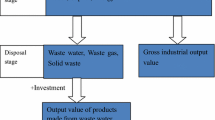Abstract
In a production process, desirable outputs and undesirable outputs are often generated simultaneously. However, lots of literature evaluating the efficiency of the industrial process always maximizes the desirable outputs regardless of the disposing of the undesirable outputs, which is improper when the environmental protection gets an increasing of attention. In this paper, we attempt to integrate the goal of maximizing the desirable outputs and that of disposing the undesirable outputs into an evaluation framework. And the generating process of the desirable outputs and the disposing process of the undesirable outputs are modeled as two connected processes, the whole of which is regarded as a two-stage process. Some data envelopment analysis models are proposed to measure the efficiencies of the two-stage process and its sub-processes. Then the example of industrial systems of Chinese administrative regions is used to examine the validity of our models. Based on the analysis of results from the example, we explain the efficiency difference in four Chinese areas and give some policy implications.



Similar content being viewed by others
Notes
In the “11th Five Year Plan”, the proportions of coal consumption accounting for the total energy consumption are 71.1, 71.1, 70.3, 70.4, 68 % respectively; the coal consumption levels of industrial terminals are 1445.6, 1957.4, 3085.1, 4125.0, 4100.9 thousand of tons respectively (the above data is from the Economic and Social Development Database of China).
References
Banker, R., Charnes, A., & Cooper, W. (1984). Some models for estimating technology and scale inefficiency in data envelopment analysis. Management Science, 30(8), 1078–1092.
Bian, Y., & Yang, F. (2010). Resource and environment efficiency analysis of provinces in China: A DEA approach based on Shannon’s entropy. Energy Policy, 38(4), 1909–1917.
Bi, G., Song, W., Zhou, P., & Liang, L. (2014). Does environmental regulation affect energy efficiency in China’s thermal power generation? Empirical evidence from a slacks-based DEA model. Energy Policy, 66, 537–546.
Charnes, A., Cooper, W. W., & Rhodes, E. (1978). Measuring the efficiency of decision making units. European Journal of Operational Research, 2(6), 429–444.
Chen, Y., Cook, W. D., Li, N., & Zhu, J. (2009). Additive efficiency decomposition in two-stage DEA. European Journal of Operational Research, 196(3), 1170–1176.
Färe, R., & Grosskopf, S. (2000). Network dea. Socio-Economic Planning Sciences, 34(1), 35–49.
Johnson, J. (2004). Putting a lid on carbon dioxide—Carbon sequestration, clean-coal research mark government response to climate-change threat. Chemical and Engineering News, 82(51), 36.
Johnson, J. (2009). The foul side of ‘clean coal’. Chemical and Engineering News, 87(8), 44–47.
Kao, C. (2009). Efficiency decomposition in network data envelopment analysis: A relational model. European Journal of Operational Research, 192(3), 949–962.
Kao, C., & Hwang, S. (2008). Efficiency decomposition in two-stage data envelopment analysis: An application to non-life insurance companies in Taiwan. European Journal of Operational Research, 185(1), 418–429.
Li, Y., Chen, Y., Liang, L., & Xie, J. (2012). DEA models for extended two-stage network structures. Omega, 40(5), 611–618.
Liang, L., Cook, W. D., & Zhu, J. (2008). DEA models for two-stage processes: Game approach and efficiency decomposition. Naval Research Logistics, 55(7), 643–653.
Liang, L., Yang, F., Cook, W. D., & Zhu, J. (2006). DEA models for supply chain efficiency evaluation. Annals of Operations Research, 145(1), 35–49.
Pekka, J. K., & Mikulas, L. (2003). Eco-efficiency analysis of power plants: An extension of data envelopment analysis. European Journal of Operational Research, 154(2004), 437–446.
Seiford, L. M., & Zhu, J. (2002). Modeling undesirable factors in efficiency evaluation. European Journal of Operational Research, 142(1), 16–20.
Sen, S. (2010). An overview of clean coal technologies I: Pre-combustion and post-combustion emission control. Energy Sources B, 5(3), 261–271.
Sharma, D. K. (1994). A new process for production of super-clean coal for industrial boilers by organosolvo-refining technique - A case for clean-coal tecnlology-transfer to industries for setting up coal refineries. Research and Industry, 39(2), 87–93.
Sharma, D. K., & Singh, S. K. (1995). Advanced process for the produciton of clean-coal by chemical leaching technique. Energy Sources, 17(4), 485–493.
Song, M., Wang, S., & Liu, Q. (2013). Envieronment efficiency evaluation considering the maximazation of desirable outputs and its application. Mathematical and Computer Modelling, 58(5–6), 1110–1116.
Steel, K. M., & Patrick, J. W. (2001). The production of ultra clean coal by chemical demineralisation. Fuel, 80(14), 2019–2023.
Wang, H., & Nakata, T. (2009). Analysis of the market penetration of clean coal technologies and its impacts in China’s electricity sector. Energy Policy, 37(1), 338–351.
Wang, K., & Wei, Y. (2014). China’s regional industrial energy efficiency and carbon emissions abatement costs. Applied Energy, 130, 617–631.
Wang, K., Yu, S., & Zhang, W. (2013). China’s regional energy and environmental efficiency: A DEA window analysis based dynamic evaluation. Mathematical and Computer Modelling, 58(5–6), 1117–1127.
Wang, Y. M., & Chin, K. S. (2010). Some alternative DEA models for two-stage process. Expert System with Application, 37(2010), 8799–8808.
Yang, M., Yang, F., & Chen, X. (2011). Effects of substituting energy with capital on China’s aggregated energy and environmental efficiency. Energy Policy, 39(10), 6065–6072.
Zhou, P., Poh, K. L., & Ang, B. W. (2007). A non-radial DEA approach to measuring environmental performance. European Journal of Operational Research, 178(1), 1–9.
Zhou, Y., Xing, X., Fang, K., Liang, D., & Xu, C. (2013). Environmental efficiency analysis of power industry in China based on an entropy SBM model. Energy Policy, 57(2013), 68–75.
Acknowledgments
This work is supported by grants from National Natural Science Founds of China (Nos. 71571174, 71631006, 71401001) and the Fundamental Research Funds for the Central Universities (WK2040160008).
Author information
Authors and Affiliations
Corresponding author
Rights and permissions
About this article
Cite this article
Fei, Y., Bi, G., Song, W. et al. Measuring the Efficiency of Two-Stage Production Process in the Presence of Undesirable Outputs. Comput Econ 54, 1343–1358 (2019). https://doi.org/10.1007/s10614-016-9621-0
Accepted:
Published:
Issue Date:
DOI: https://doi.org/10.1007/s10614-016-9621-0




